By JEFFREY RESSNER
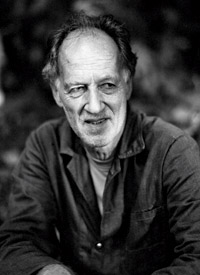 A fever dream. That’s how Werner Herzog often describes Fitzcarraldo, his 1982 outré masterpiece starring the late eccentric actor Klaus Kinski. The story line, about a Caruso-obsessed entrepreneur and his quest to raise funds for an opera house in the Amazon jungle, has been largely overshadowed by one extraordinary sequence unlike anything ever captured on film before or since. Attempting to reach an impossibly remote but potentially lucrative rubber-tree plantation, Kinski’s character decides to maneuver his steamboat from one river tributary to another by dragging the ship over the top of a mountain in the rain forest.
A fever dream. That’s how Werner Herzog often describes Fitzcarraldo, his 1982 outré masterpiece starring the late eccentric actor Klaus Kinski. The story line, about a Caruso-obsessed entrepreneur and his quest to raise funds for an opera house in the Amazon jungle, has been largely overshadowed by one extraordinary sequence unlike anything ever captured on film before or since. Attempting to reach an impossibly remote but potentially lucrative rubber-tree plantation, Kinski’s character decides to maneuver his steamboat from one river tributary to another by dragging the ship over the top of a mountain in the rain forest.
Most directors faced with this kind of plot development would figure out a cinematic shortcut, but not Herzog, whose insistence on keeping it real led him to actually take the boat over the hill, using only primitive block and tackle manned by teams of Campa Ashaninka Indians and a Caterpillar bulldozer. Despite three years of preproduction, there was absolutely no storyboarding (“An instrument of the cowards,” sneers Herzog), no computer effects or miniature models (“A plastic solution,” he says)—just a unique vision and the sheer will and determination to get the job done. Altogether, it took the crew less than two weeks to move the 340-ton ship up and then down the peak.
Herzog, the one-time enfant terrible of the German new wave, has produced an extraordinary body of personal work, but Fitzcarraldo remains perhaps his most iconic and remarkable film. “When we are talking about these shots,” he says, “parts of them were dictated by the necessities of the engineering feat, parts of them were dictated, of course, by the needs of the story, and then there was always open space for the unexpected.”
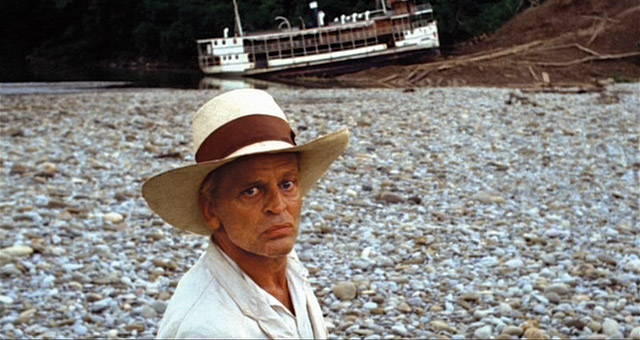
I decided to have a shot of Kinski contemplating the enormity of what is lying ahead, so you see him in the foreground and the task is in full focus in the background. I very much like using wide-angle lenses like these because they’re very demanding—you cannot cheat anything away in soft focus in the background. This shot was also dictated by the events. Behind Kinski is a huge field of gravel and stones that used to be the actual river, but the water level had fallen to unprecedented lows. Kinski is standing there, and fortunately enough the ship had been pulled a little bit on land, but we should have had water here behind him.

In the story, the natives all disappeared after an accident and there was a secret exodus that we don’t see. Mysteriously, they all return and this shot shows them coming back all of a sudden. I always saw their return as a wide-angle shot. I used the plateau as a large platform, almost like a stage. I never wanted to go close—this had to be a wide shot. All of these shots were filmed with natural light, with not one reflector, not ever. No additional artificial light. Also, there was no Steadicam, no crane, no dolly—just a tripod and sometimes a handheld camera. We mostly shot with one camera—an Arriflex. It’s very sturdy when it comes to rain and jungle and humidity and bumping it around. They’re good workhorses.
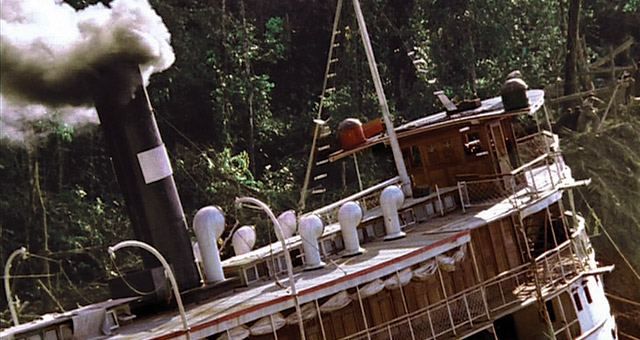
I needed a somewhat closer shot here, otherwise it’s hard to tell that the ship was actually moving against the forest. It’s hard to perceive with a wide lens, so we needed a closer lens. We had a regular set of lenses between 18 mm and something like 85 mm, but we hardly ever used the longer lenses. The film was basically shot with one 24 mm lens. I just shot what naturally happened. I had staged a huge mechanical event, which is out of proportion for a film, and then I just covered it the best I could. I wasn’t necessarily out for realism. When you see this scene in the context of the entire film, it seemed like some huge operatic highlight, like a scene out of a grand opera.
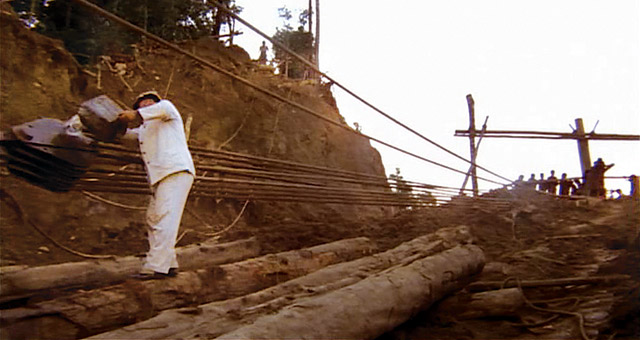
This was another scene totally dictated by unexpected necessities—a steel cable had ruptured because the tension had gotten so incredibly high. Really, the pressure inside the cable gets so high that it becomes glowing hot inside, incandescent. We realized that inside this enormous pulley system that the cables started to heat up, and we could tell by tapping them with a stone or a stick, listening for the sound it made. It didn’t sound right anymore, so I had the actor who played the captain cool down the cables with buckets of water. This is something we did not expect, but we had to do it.

When the ship really moved it was a rare, jubilant moment and you have to have the actors in the frame. You can shoot it only once—there are no second takes. The ship moves perhaps 30 feet in a minute, and then it takes days to reset things and the whole system had to be changed. What you see here is one shot, one chance to do it, and so you had better do it wide angle. I gave the actors limits for their movement, but they had sufficient space to move. Kinski was always very precise and understood just what the camera sees. But the other actor was a bar owner who got quite tipsy when we did this shot and he never knew where the frame ended. I had to literally lift him into the scene and say, ‘Go do it!’
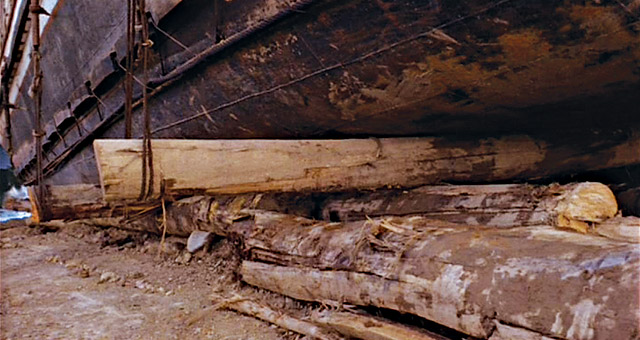
Here I decided to show what was decisive for the technical feat, some details of how it was done. When we first tried to pull the ship uphill, it immediately dug like a plow into the mountain and got stuck. You have to use logs and trees rolling underneath the boat, something on which it can slide. We tried all sorts of things until we found the right system. To force tree trunks under the hull of a ship is something of great enormity. I wanted to give the audience the chance to see the boat really move and how monstrous this whole thing was. I wanted them to trust their eyes and realize this was no model.
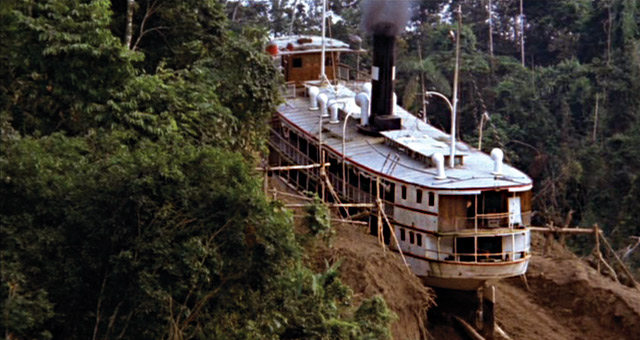
Throughout the film, the ship moves from left to right, and you always have a sense in which direction you are moving. But in this shot, I jumped the axis. It was totally against my convictions, jumping across the axis of the movement. It’s not serious or even perceptible, but it was because only from this perspective do you see the ship actually immersing itself, as if it’s going into a tunnel of jungle, as if the ship is becoming a natural part of the rain forest itself. I think we were on a small platform we had built high up in a tree when we shot this.
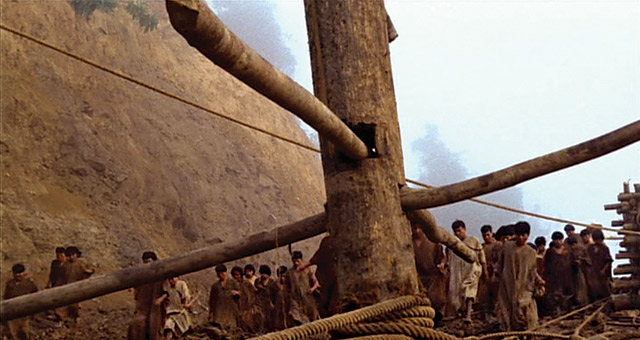
To say we were ‘engineering’ is a little bit farfetched. We had lumbermen and a Caterpillar driver and native Indians moving multiple winch systems as you see here. The natives are moving quickly into position because I wanted to use the morning fog and I knew it would lift in a half hour or so. I assembled as many as I could—we had up to 800 natives in a camp a few hundred yards away. I said, ‘Boys, come on, this is wonderful’ and they manned the winches and started working again. They were all very disciplined on the set, we had a good rapport, and they worked professionally very well. A good amount of the men came to me privately and offered to kill Kinski. They were serious, of course; it was not a joke.
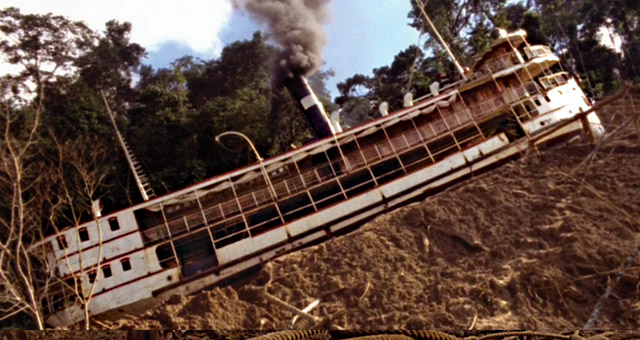
You have to see the entire ship moving. The crew understood that it had to be in one single shot. And if we failed to do that, the film was going to fail. There was no coverage, it’s just what it is. And you are a witness. In shots like this we would have a second camera next to the main position. Doing any closer shots would have meant losing a lot. You see, I’m not into this Hollywood mood or this film school mood where you cover in a close-up. How does a close-up help you here? You have to see the entire ship moving.
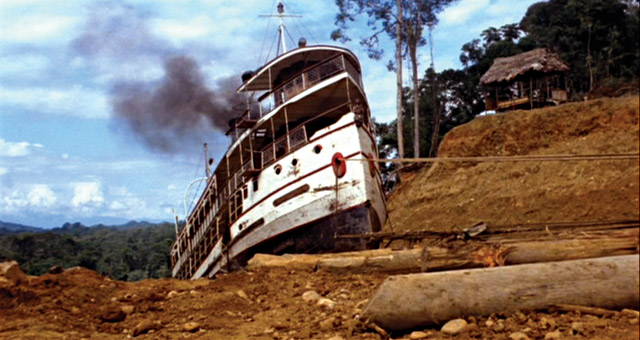
In this shot the ship reached the peak of the mountain and I placed the camera very low, something like one or two feet off the ground. I wanted to see the clouds and the background landscape so it seemed as if the ship was really almost being lifted into the sky, rising up. If I had the camera any higher, it wouldn’t have looked like that anymore. The shot was so evident to me—you see what’s going to happen and right away you know to put the camera low and you shoot it, just like that.
In the previous shot where the ship rises to the sky, you get the sense there’s no gravity anymore. But this shot points out that there are still the forces of nature out there. And they will punish you. Again, I wanted the audience to see the detail, how the cable is wrapped around this 340-ton ship like a huge belt against it. It’s hard to explain, but I believe these close shots were valuable so audiences could see the enormity of our task—it somehow displays way better in a close shot.
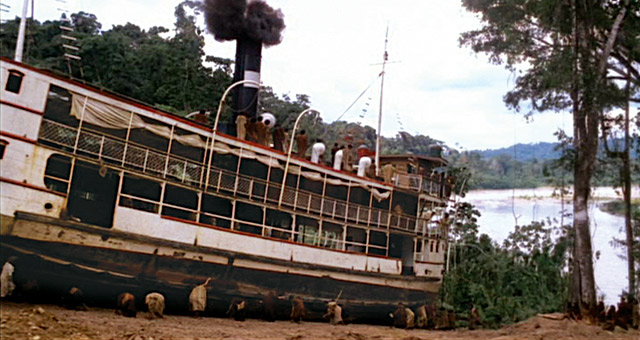
You do not need that much force going down, it was more of finding a delicate balance. If you push the ship too much, it’s going to slide and all hell will break loose and it will go down like an avalanche. That was the major complication in this. What you have to know is, in between the ship reaching the top and it going down into the river, we took a six-month hiatus, because the river was only a trickle of water due to the dry season. We left the boat at the top of the mountain and hired a large family to live on the ship—we had to fight the vines and the rust, and protect it from being disassembled for the iron and the wood.
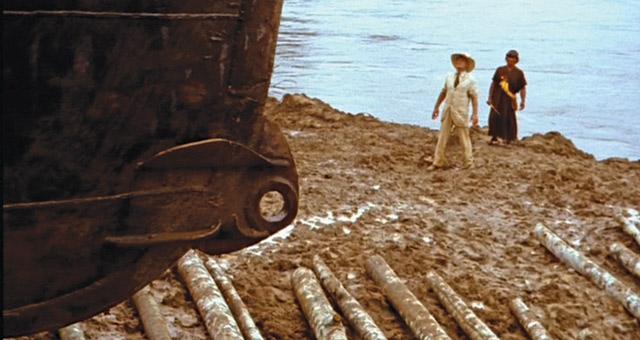
Look at Kinski in his suit! We shot this with two cameras—one very close to the edge of the slope. You can shoot a scene like this only once—you cannot pull the boat back up and do a second take. I remember rushing between the two cameras and how muddy it was—sometimes you’d sink to your hips. I was running around barefoot and stepped onto a broken beer bottle. Despite the fact I was bleeding badly, I kept running. I remember at the time how the shards of glass in my foot had as much importance to me as the ship going into the water. But I could not miss a beat on the shot, I had to perform, I had to deliver, no matter what.

The ship was completely battered at this point, and it’s going into the river where it almost capsized. It was very precarious and the captain is still there in the upper right hand part of deck. I was basically standing by the camera and had 10 courageous men, all good swimmers, ready to go in for the captain had the ship capsized. We would have gotten him out. We didn’t expect the ship to capsize, and wondered why it started to do so against the current of the river. I expected it to push off the water and come toward the camera. It wasn’t natural but, then again, we were imposing ourselves against the laws of nature.